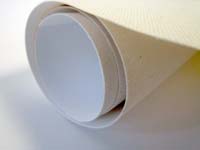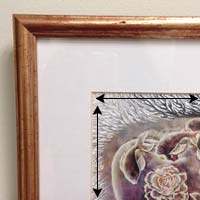I
Indenting overmats A mat with an inside edge that has been pressed or stamped with a scoop or bevel indentation. This adds extra depth and interest to the matted artwork. |
| Infrared Energy Light waves that can heat and therefore dry out artwork over a period of time, speeding up the decay process. Sunlight and tungsten have infrared energy. Ideally, artwork should be kept out of direct light. |
| Ink and print fading time To lose or cause to lose brightness or brilliance. The fading time of ink jet ink is a direct result of the inks that you choose, as well as the environment where the print is displayed. All dye-based inks fade noticeably under direct sunlight and in interior applications where direct sunlight may fall on the image, and/or, where fluorescent or other UV lighting is present. Although the fading process is inherent in all ink jet inks, certain UV enhanced inks, pigment-based inks, and UV inhibiting coatings will extend the longevity of ink color. |
Inkjet Canvas Artist canvas that is specially coated to be printed on using an inkjet printer. The type of coating used will vary from brand to brand, but can result in a canvas that is water-resistant, fast-drying, and/or acid-free (conservation-grade). Additionally, the coatings must be flexible, as canvas prints are generally stretched over a wooden frame.
There are 100% cotton and poly-cotton inkjet canvases available. 100% cotton has a richer texture, but the color can vary along the roll. Poly-cotton canvas is very consistent from print to print, but may have less texture. |
 |
| Inlaid frames A subtractive technique most commonly used on natural wood frames, where the decorative design is carved or stamped into the frame face rather than added to it, resulting in reverse-relief ornamentation. The frame is then finished with varnish or paint. |
| Inlay A subtractive technique; the carving or stamping of a design into a flat surface, resulting in a reverse-relief decoration. |
 |
| Inlay Mat Used to create the look of a double mat in a single layer. Rather than stacking the mats on top of one another and cutting the bottom mat opening slightly smaller than the top mat, the exposed area ("reveal") of the bottom mat is cut out and affixed inside the top mat opening, creating a single mat layer with two colors. |
| Inner mat If a framed artwork has a double mat (a top mat, usually 2" wide, and a bottom mat with a reveal of approximately 1/2"), "inner mat" refers to the bottom mat, of which only a small amount is seen. |
 |
| Inner space The dimensions of the mat opening, or the space between the picture frame sides when no mat is used. These are the dimensions of your artwork that will be visible. |
 |
| Inside size This is the measurement of the space into which your artwork will be placed. If the frame is intended for an 11x14" image, the inside size will likely be approximately 11 1/8" x 14 1/8". 1/16" is added to each side to accommodate the potential expansion of the contents due to humidity and temperature changes. |
Invasive Mounting Any method of affixing artwork to another surface that cannot be undone. Once the adhesive or glue is applied, a residue from the substance will remain on the artwork.
Invasive mounting methods are not conservation-grade. |

